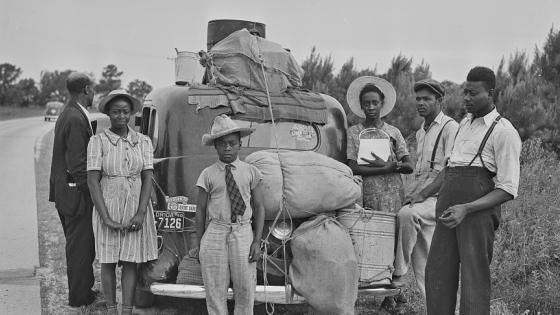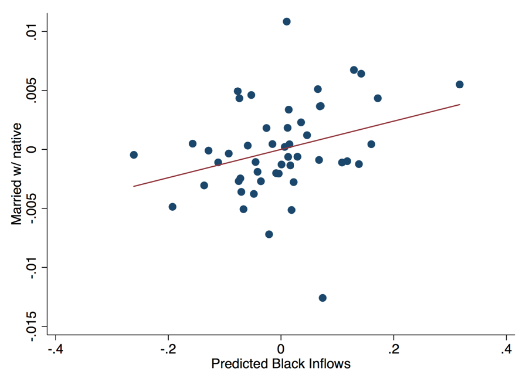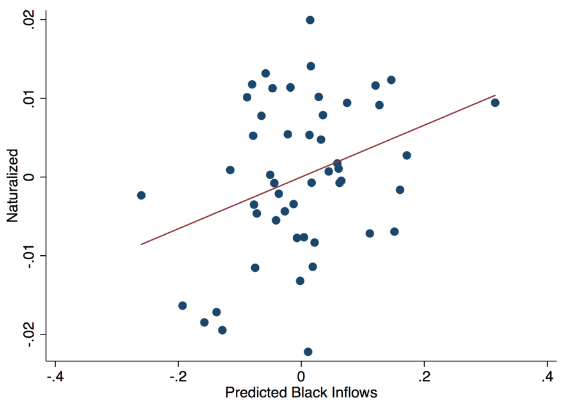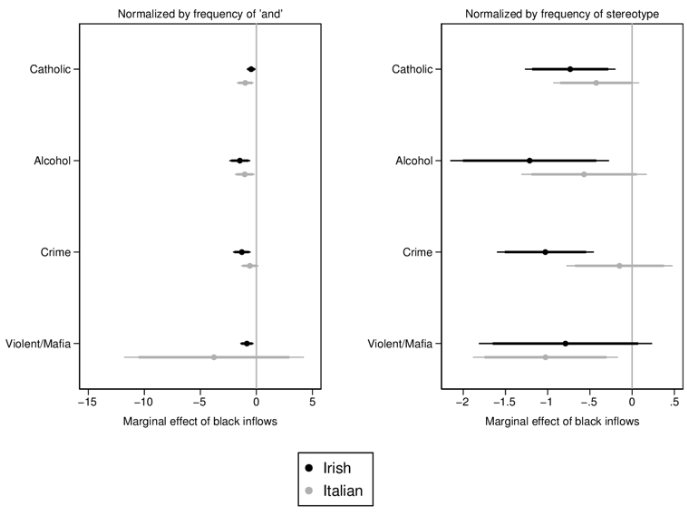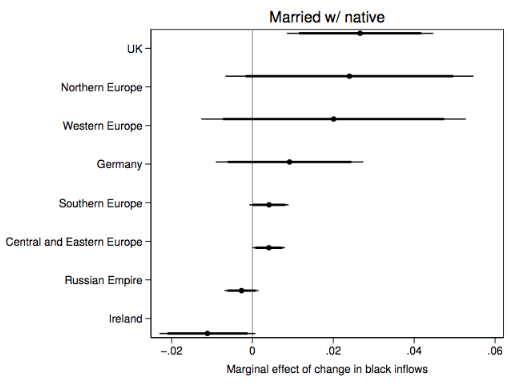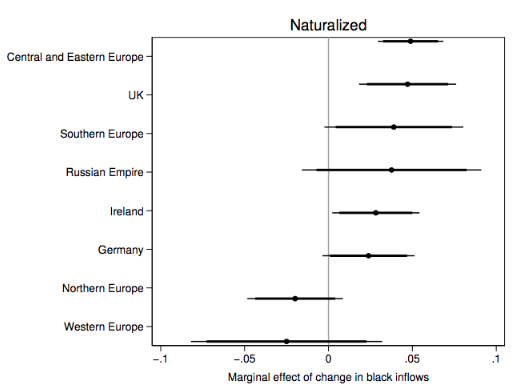Immigration is one of the major economic and political issues of our times. As of 2017, there were almost 260 million migrants around the world (United Nations 2017). Although immigration and diversity can have large economic benefits (Alesina and La Ferrara 2005, Ottaviano and Peri 2012), they are often cast as a threat to receiving countries' social cohesion (Alesina et al. 1999, Collier 2013, Putnam 2007). While the standard policy intuition is that more immigration will exacerbate such effects, diversity can also increase national unity through non-economic channels (Bazzi et al. 2019). One such channel works through changes in assimilation incentives and opportunities for earlier generations of migrants. Somewhat surprisingly, there is little empirical evidence demonstrating how the arrival of new ethnic or social groups affects the assimilation of existing minorities. Can it facilitate their incorporation, thus dampening the potential negative effects of diversity? Or, does it hinder their assimilation by fuelling the native population’s backlash against all minorities?
Our paper (Fouka et al. 2019) addresses this question in the context of US history. Between 1850 and 1915, during the Age of Mass Migration, the US attracted close to 30 million European immigrants, and the foreign-born share of the US population peaked at 14% – even higher than today's share of 13.7% (Abramitzky and Boustan 2017). Immigrant integration was a topic of political debate (Vigdor 2010), much as it is today. Nativism and anti-immigrant attitudes were widespread, especially towards Eastern and Southern Europeans, who were perceived as religiously and culturally different from native Anglo-Saxons (Higham 1955). Yet, early 20th century immigrants, albeit at varying rates and less quickly than originally thought (Chiswick 1978), eventually assimilated economically and culturally into American society, fuelling the myth of the American melting pot (Abramitzky et al. 2014, 2020).
In our study, we test the idea that an important role in catalysing this assimilation was played by the migration of another group, namely, African Americans. From 1915 to 1930, approximately 1.6 million African Americans migrated for the first time from the US South to cities in the North and West. This unprecedented migration episode – termed the Great Migration – was triggered by wartime manufacturing needs in the North during WWI, and the combination of increased violence and declining agricultural productivity in the South (Boustan 2016).
The Great Migration as a historical case study
We test our proposal by comparing European immigrants across Northern cities that received varying numbers of African Americans, before and after the Great Migration. To account for the fact that African Americans may have sorted into more rapidly growing (or declining) cities that also witnessed faster (or slower) immigrant assimilation, we follow a large literature in economics to predict African American in-migration (Card 2001). This strategy combines variation in historical (pre-Great Migration) settlements of southern-born African Americans across northern cities with differential emigration rates of African Americans across southern states after 1910.
Relying on recently digitised census data on the entire US population from 1910-1930, we find that immigrants living in cities with higher rates of African American in-migration were more likely to become naturalised citizens — a proxy for assimilation effort — and to marry someone native-born (e.g. of native parentage) — a key proxy for successful integration. Figure 1 illustrates these results. To support a causal interpretation of these patterns, we show that neither naturalisation rates nor intermarriage were already trending differentially across northern cities before the Great Migration. We also construct a linked sample of immigrants who stayed in the same city throughout the period 1910-1930 to reduce concerns that our results may be driven by the selective out-migration of less assimilated immigrants.
Figure 1 Effect of African American inflows, as predicted by 1900 northern settlements, on intermarriage (top panel) and naturalisation rates (bottom panel)
Source: adapted from Fouka et al. (2019)
Native attitudes and assimilation
In the second part of the paper, we investigate the mechanisms behind our key results. First, we test whether native discrimination against immigrants decreased, as race was re-defined in terms of skin colour rather than ethnicity during the Great Migration. Using data from local newspapers, we show that newspapers in the cities that received more African Americans were less likely to use words that reflected fears of immigration or concerns about immigrant assimilation. We also document that the Great Migration reduced the frequency of disparaging ethnic stereotyping, such as the association of Italians with the word “Mafia” or Irish with the word “violence” or “alcohol”. Figure 2 reports results for this exercise, dividing the joint frequency of ethnicity and stereotypes by the frequency of the generic word “and” in the left panel and by the frequency of the stereotype in the right panel.
Figure 2 Marginal effect of African American inflows on the relative frequency of ethnic stereotype
Source: adapted from Fouka et al. (2019).
Next, we document the fact that immigrants who were considered culturally closer to natives (e.g. Northern and Western Europeans) were more likely to successfully assimilate in response to the Great Migration. This pattern holds despite the fact that these same groups were significantly less likely to exert effort to assimilate (Figure 3). The opposite is true for groups that were considered culturally further from natives, such as Southern and Eastern Europeans. These groups, disproportionately employed in manufacturing and in unskilled occupations, were more directly exposed to labour market competition from African Americans, and reacted to it by increasing efforts to signal an American identity through naturalisation. Taken together, these results suggest that the sudden arrival of African Americans changed the native population’s acceptance of immigrants in a way that favoured more culturally proximate Europeans (those regarded as ‘whiter’). Despite a larger increase in Americanisation efforts among Southerners and Easterners, only immigrants who were perceived as ‘sufficiently close’ to the native population were able to become incorporated within it.
Figure 3 Marginal effect of African American inflows on the probability of intermarriage (top) or being a US citizen (bottom) by region of origin
Source: adapted from Fouka et al. (2019).
Finally, we provide evidence against alternative mechanisms. In particular, we rule out the possibility that African American inflows economically benefitted certain groups (i.e. Northern and Western Europeans) while harming others (i.e. Eastern and Southern Europeans), and that social assimilation directly followed from economic assimilation. In fact, the economic effects of the Great Migration were very similar across immigrant groups: regardless of national origin, European immigrants left the ‘immigrant-intensive’ (and low paying) manufacturing sector at similar rates. This is in contrast with the social effects described before, which instead varied by cultural proximity to native Anglo-Saxons, suggesting that native attitudes played a central role in driving our results.
Conclusion
Our findings suggest that the salience of new ‘low-status’ groups can alter the majority’s perceptions of previous outsiders, and might be an important driver of immigrant assimilation.
While recent research has examined the effects of inclusive (Hainmueller et al. 2017) or assimilationist (Fouka 2020) policies on immigrant integration, our study suggests that much assimilation happens organically, via the interaction of new and old immigrant out-groups. Our results also highlight the importance of native acceptance in driving immigrant assimilation. The Great Migration in the US may have unique features, but evidence suggests that these mechanisms are likely to apply more broadly in a variety of settings. In a follow-up study (Fouka et al. 2020), we show that Mexican immigration to the US between 1970 and 2010 improved white American’s attitudes towards African Americans and reduced anti-black hate crimes, as immigrant status became more salient relative to race. We believe that the framework used in our work can thus be extended to study more broadly the role played by new minorities on the outcomes of more established minority groups.
References
Abramitzky, R, L P Boustan and K Eriksson (2014), “A Nation of Immigrants: Assimilation and Economic Outcomes in the Age of Mass Migration”, Journal of Political Economy 122(3): 467-506.
Abramitzky, R, L P Boustan and K Eriksson (2020), “Do Immigrants Assimilate More Slowly Today Than in the Past?”, American Economic Review: Insights 2(1): 125-141.
Abramitzky, R and L P Boustan (2017), “Immigration in American Economic History”, Journal of Economic Literature 55(4): 1311-1345.
Alesina, A, R Baqir and W Easterly (1999), “Public Goods and Ethnic Divisions”, Quarterly Journal of Economics 114(4): 1243-1284.
Alesina, A and E L Ferrara (2005), “Ethnic Diversity and Economic Performance”, Journal of Economic Literature 43(3): 762-800.
Bazzi, S, A Gaduh, A D Rothenberg and M Wong (2019), “Unity in Diversity? How Intergroup Contact Can Foster Nation Building", Working Paper.
Boustan, L P (2016), Competition in the Promised Land: Black Migrants in Northern Cities and Labor Markets, Princeton University Press.
Card, (2001), “Immigrant Inflows, Native Outflows, and the Local Labor Market Impacts of Higher Immigration", Journal of Labor Economics 19(1): 22-64.
Chiswick, B R (1978), “The Effect of Americanization on the Earnings of Foreign-Born Men", Journal of Political Economy 86 (5): 897-921.
Collier, P (2013), Exodus: How Migration Is Changing Our World, Oxford University Press.
Fouka, V (2020), “Backlash: The Unintended Effects of Language Prohibition in US Schools after World War I”, The Review of Economic Studies 87(1): 204-239.
Fouka, V, S Mazumder and M Tabellini (2019), “From Immigrants to Americans: Race and Assimilation during the Great Migration”, Working paper.
Fouka, V, S Mazumder and M Tabellini (2020), “Changing In-Group Boundaries: the Effect of Immigration on Race Relations in the US”, Working paper.
Hainmueller, J, D Hangartner and G Pietrantuono (2017), “Catalyst or Crown: Does Naturalization Promote the Long-Term Social Integration of Immigrants?”, American Political Science Review 111(2): 256-276.
Higham, J (1955), Strangers in the Land: Patterns of American Nativism, 1860-1925, New Brunswick: Rutgers University Press.
Ottaviano, G I P and G Peri (2012), “Rethinking the Effect of Immigration on Wages", Journal of the European Economic Association 10 (1): 152-197.
Putnam, R D (2007), “E Pluribus Unum: Diversity and Community in the Twenty-First Century”, The 2006 Johan Skytte Prize Lecture, Scandinavian political studies 30(2): 137-174.
United Nations, Department of Economic and Social Affairs, Population Division (2017), Trends in International Migrant Stock: The 2017 Revision, United Nations database, POP/DB/MIG/Stock/Rev.
Vigdor, J L (2010), From Immigrants to Americans: The Rise and Fall of Fitting In, Lanham: Rowman&Littlefield Publishers.
